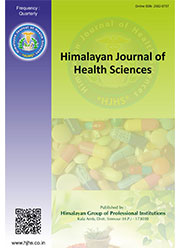Pyridazine: A Magical Moiety
Abstract
Introduction: A heterocyclic organic molecule having the chemical formula, C4H4N2. It is aromatic and has a 6-membered ring with two nearby nitrogen atoms. It has a specific heat of 208 °C and is an inert liquid. This paper presents a complete summary of the phytochemical and pharmacological activity of pyridazine as well as its derivatives published to date using new research findings and a wide variety of data.
For the study, authors' scientific journal articles on pyridazine as well as its derivatives were investigated.
The pharmacological properties of pyridazine as well as its derivatives include anti-cancer, anti-hypertensive, anti-allergic, anti-histaminic, eosinophil chemotaxis-inhibiting, anti-inflammatory, anti-PAF (thrombin factor), anti-HIV, and anti-histaminic effects.
Conclusion: Pyridazine and its derivatives are involved in many pharmaceutical procedures. Although researchers have highlighted the crucial roles pyridazines and its derivaives that fulfills, we emphasize that further laboratory studies should be conducted in order to broaden the breadth of this compound's possible applications.
References
2. Wermuth C G. Are pyridazines privileged structures?. MedChemComm. 2011;2(10):935-941.
3. Byrichetti K. "Synthesis and Structure of a Substituted Pyridazine". Masters Theses & Specialist Projects. Paper 1080 [Internet]. 2011 [cited 15 Aug 2022]. Available from:
http://digitalcommons.wku.edu/theses/1080
4. Lenhert A G, Castle, R N. Pyridazines. New York. NY: John Wiley and Sons; 1973.p.12.
5. Mizzoni R H, Spoerri, P E. Synthesis in the pyridazine series. I. Pyridazine and 3, 6-dichloropyridazine. Journal of the American Chemical Society. 1951;73(4):1873-1874.
6. Abdelrazek FM, El-Din A M S, Mekky AE. Further studies on the reaction of ethyl benzoylacetate with malononitrile: synthesis of some novel pyridine and pyridazine derivatives. Tetrahedron. 2001;57(31),:6787-6791.
7. Evans S, Schweizer, E E. A facile and general pyridazine synthesis from alpha-diketone monohydrazones and beta-oxo esters or beta-diketones. The Journal of Organic Chemistry.1977;42(13):2321-24.
8. George L, Veedu RN, Sheibani H, Taherpour AA, Flammang R, Wentrup C. Carboxyketenes from 4-hydroxy-1, 3-oxazin-6-ones and Meldrum's acid derivatives. The Journal of Organic Chemistry. 2007;72(4):1399-1404.
9. Carboni R A, Lindsey Jr, R V. Reactions of tetrazines with unsaturated compounds. A new synthesis of pyridazines. Journal of the American Chemical Society. 1959;81(16):4342-4346.
10. Gao Y, Twamley B, Shreeve JNM. The first (ferrocenylmethyl) imidazolium and (ferrocenylmethyl) triazolium room temperature ionic liquids. Inorganic chemistry. 2004;43(11):3406-3412.
11. Joule J A, Mills, K. Heterocyclic chemistry at a glance. John Wiley & Sons; 2012.
12. Yildiz-Oren I, Yalcin I, Aki-Sener E, Ucarturk, N. Synthesis and structure–activity relationships of new antimicrobial active multisubstituted benzazole derivatives. European Journal of Medicinal Chemistry. 2004;39(3):291-298.
13. Vane J R, Botting, R M. Mechanism of action of anti-inflammatory drugs. Scandinavian Journal of Rheumatology. 1996;25(sup102):9-21.
14. Behalo M S, Gad El-karim I A, Issac Y A, Farag, M A. Synthesis of novel pyridazine derivatives as potential antimicrobial agents. Journal of Sulfur Chemistry.2014;35(6):661-673.
15. Etebu E, Arikekpar, I. Antibiotics: Classification and mechanisms of action with emphasis on molecular perspectives.Int. J. Appl. Microbiology Biotechnology Res. 2016;4(2016):90-101.
16. Leekha S, Terrell C L, Edson, R S. General principles of antimicrobial therapy. In Mayo clinic proceedings. Elsevier. 2011;86(2):156-167
17. Sharma V K, Yngard R A, Lin Y. Silver nanoparticles: green synthesis and their antimicrobial activities. Advances in colloid and interface science. 2009;145(1-2):83-96.
18. Chopra A, Doiphode, V V. Ayurvedic medicine: core concept, therapeutic principles, and current relevance. Medical Clinics. 2002;86(1):75-89.
19. Gurung N, Ray S, Bose S, Rai, V. A broader view: microbial enzymes and their relevance in industries, medicine, and beyond. BioMed research international. 2013.
20. Liwa A C, Jaka, H. (2015). Antimicrobial resistance: Mechanisms of action of antimicrobial agents. The Battle Against Microbial Pathogens: Basic Science, Technological Advances and Educational Programs. 2015;876-885.
21. Suzen, S. Recent developments of melatonin related antioxidant compounds. Combinatorial Chemistry & High Throughput Screening. 2006;9(6):409-419.
22. Imada I, Sato EF, Miyamoto M, Ichimori Y, Minamiyama Y, Konaka R, Inoue, M. Analysis of reactive oxygen species generated by neutrophils using a chemiluminescence probe L-012. Analytical biochemistry. 1999;271(1):53-58.
23. Cuzzocrea, S. Role of nitric oxide and reactive oxygen species in arthritis. Current pharmaceutical design. 2006;12(27):3551-70.
24. Supinski G S, Callahan, L A. Free radical-mediated skeletal muscle dysfunction in inflammatory conditions. Journal of applied physiology. 2007;102(5):2056-2063.
25. Craft J M, Watterson D M, Frautschy S A, Van Eldik, L J. Aminopyridazines inhibit β-amyloid-induced glial activation and neuronal damage in vivo. Neurobiology of aging. 2004;25(10):1283-92.
26. Hashem HE, Haneen DS, Saied KF, Youssef, AS. Synthesis of new annulated pyridazine derivatives and studying their antioxidant and antimicrobial activities. Synthetic Communications. 2019;49(22):3169-80.

This work is licensed under a Creative Commons Attribution-NonCommercial 4.0 International License.
The International Journal of Innovative Science & Technology affairs require a formal written transfer of copyright from the author(s) for each article published. We therefore ask you to complete and return this form, retaining a copy for your records. Your cooperation is essential and appreciated. Any delay will result in a delay in publication.
I/we have read and agree with the terms and conditions stated Page 2 of this agreement and I/we hereby confirm the transfer of all copyrights in and relating to the above-named manuscript, in all forms and media, now or hereafter known, to the International Journal of Drug Regulatory affairs, effective from the date stated below. I/we acknowledge that the IJDRA is relying on this agreement in publishing the above-named manuscript. However, this agreement will be null and void if the manuscript is not published in the IJIST.
Download link for COPYRIGHT FORM





